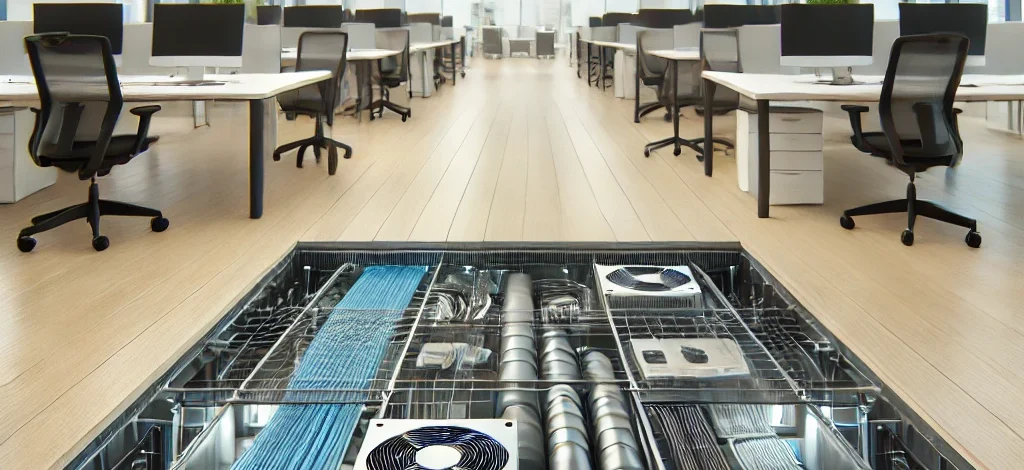Maximize Energy Efficiency with Raised Flooring Systems
Raised flooring systems have revolutionized modern building designs by offering not only structural flexibility but also significant energy savings. By creating an underfloor plenum, these systems facilitate efficient air distribution, leading to reduced energy consumption and enhanced indoor comfort.
In today’s rapidly evolving architectural landscape, the emphasis on energy efficiency and sustainable design has never been more pronounced. Raised flooring systems have emerged as a pivotal solution, marrying functional versatility with substantial energy conservation benefits.
Understanding Raised Flooring Systems
A raised flooring system consists of modular floor panels supported by adjustable pedestals, creating a void between the structural slab and the flooring surface. This void serves multiple purposes, including housing electrical wiring, data cabling, and, notably, acting as an air distribution plenum for HVAC systems.
Mechanism of Energy Savings
-
Efficient Air Distribution: Traditional HVAC systems often rely on ceiling-based air delivery, which can lead to uneven temperature distribution and increased energy usage. Raised flooring systems, however, utilize the underfloor space to deliver conditioned air directly to occupied zones. This method, known as Underfloor Air Distribution (UFAD), ensures a more uniform temperature profile and reduces the workload on HVAC units.
-
Reduced Fan Energy Consumption: With air being supplied from the floor level, there’s a natural buoyancy-driven rise of warm air, promoting efficient thermal stratification. This allows HVAC systems to operate at lower fan speeds, leading to notable energy savings.
-
Targeted Cooling: In environments like data centers, where equipment generates substantial heat, raised floors enable precise delivery of cool air to specific hotspots, enhancing cooling efficiency and reducing overall energy consumption.
Real-World Applications and Benefits
-
Data Centers: Data centers, notorious for their high energy consumption due to cooling demands, have benefited immensely from raised flooring systems. By facilitating efficient airflow and targeted cooling, these systems can significantly reduce energy bills.
-
Commercial Buildings: Office spaces equipped with raised floors experience enhanced indoor air quality and occupant comfort. The flexibility to reconfigure workspaces without major HVAC overhauls further contributes to operational efficiency.
-
Sustainable Design: Incorporating raised flooring aligns with green building standards, as they can lower HVAC energy use by up to 30%, aiding in achieving certifications like LEED.
-
Flexibility: The modular nature of raised floors allows for easy reconfiguration of spaces, accommodating evolving technological and organizational needs without significant disruptions.
-
Improved Maintenance: With utilities housed beneath the floor, maintenance becomes more straightforward, reducing downtime and associated costs.
Considerations
While the benefits are substantial, it’s essential to consider factors such as initial installation costs and structural load capacities. Proper design and implementation are crucial to maximize the energy-saving potential of raised flooring systems.
| Specification | Details |
|---|---|
| Panel Material | Steel, concrete-filled, aluminum, or woodcore panels |
| Standard Panel Size | Typically 600mm x 600mm |
| Panel Thickness | Varies based on material and load requirements, generally between 30mm to 40mm |
| Load Capacity | Ranges from 1,250 to 2,500 pounds per square foot, depending on system design and application |
| Pedestal Height Adjustment | Adjustable from 3 inches to 24 inches or more, accommodating various plenum space requirements |
| Understructure Options | Bolted stringer, snap-on stringer, or stringerless systems |
| Airflow Panels | Perforated or gridded panels with up to 25% open area for optimal air distribution |
| Fire Resistance Rating | Compliant with international fire safety standards, varying by material |
| Antistatic Properties | Available with antistatic finishes for sensitive environments like data centers |
| Surface Finish Options | High-pressure laminate, vinyl, carpet, or bare finish for various aesthetic and functional needs |
| Accessibility | Panels designed for easy removal, facilitating quick access to underfloor services |
| Sustainability | Options available with recycled content and low VOC emissions, contributing to green building certifications |
| Integration Capabilities | Compatible with underfloor air distribution (UFAD) systems and other building services |
| Durability | Engineered to withstand heavy foot traffic and equipment loads, ensuring long-term performance |
| Acoustic Performance | Enhanced sound absorption properties to improve indoor acoustic comfort |
| Seismic Compliance | Systems available with seismic bracing for installations in earthquake-prone regions |
Product FAQs:
-
How do raised flooring systems contribute to energy savings?
- By utilizing the underfloor space for air distribution, raised flooring systems enable efficient cooling and heating, reducing the workload on HVAC systems and leading to energy savings.
-
Are raised flooring systems suitable for existing buildings?
- Yes, raised flooring systems can be retrofitted into existing structures, though considerations regarding floor-to-ceiling height and structural load capacities are essential.
-
What maintenance is required for raised flooring systems?
- Regular inspections ensure panels and pedestals remain secure. The accessible underfloor space simplifies maintenance of utilities, reducing downtime.
-
Do raised flooring systems support heavy equipment?
- Absolutely. Raised flooring systems are engineered to handle substantial loads, making them ideal for data centers and industrial applications.
-
How do raised flooring systems improve indoor air quality?
- By facilitating efficient air distribution and reducing dust accumulation, raised flooring systems contribute to a healthier indoor environment.
Why Choose Raised Flooring Systems for Energy Savings
Opting for raised flooring systems is a strategic decision for organizations aiming to enhance energy efficiency. The ability to optimize HVAC operations, coupled with the flexibility to adapt to future technological advancements, makes raised flooring a forward-thinking solution. Moreover, the potential for reduced operational costs and improved occupant comfort underscores their value in modern building design.
Maximize Energy Efficiency with Raised Flooring Systems
|
|
|
|



